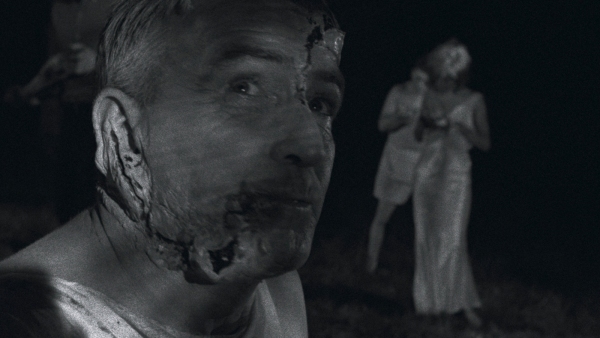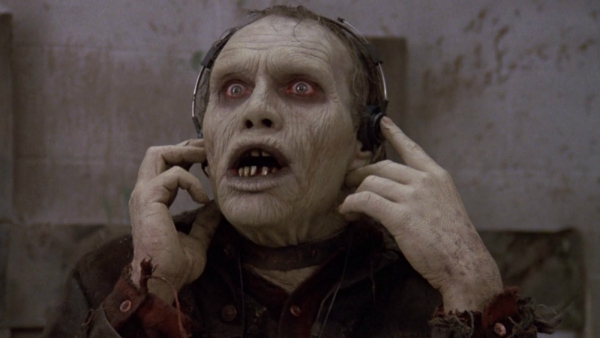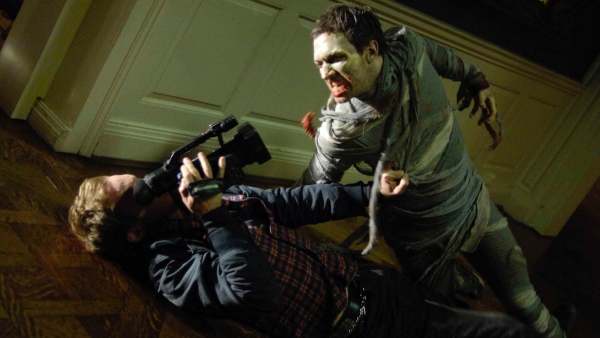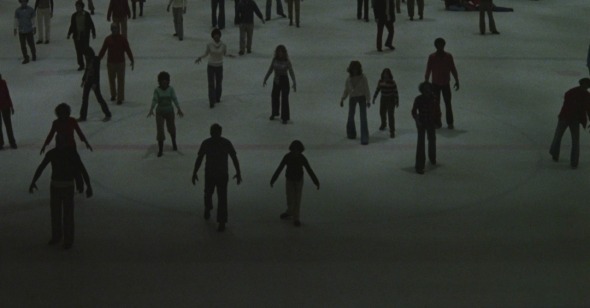We Walk:
George A. Romero’s Eternal Zombie Cycle
By Chris Shields
The screening series Films of the Dead: Romero & Co. plays June 25–July 30, 2022 at Museum of the Moving Image, in conjunction with the Museum's exhibition Living with The Walking Dead.
If you find yourself in Pennsylvania, outside of Pittsburgh, and you have an hour to spare, you might type “Evans City Cemetery” into your GPS. Eventually, you will make your way onto a lonely country road that ascends to a small cemetery nestled in the woods. It was here, in 1968, that George A. Romero shot the opening scene of his genre-defining film Night of the Living Dead. The place remains very much unchanged from the time Barbara (Judith O’Dea) and her sarcastic no-goodnik brother, Johnny (Russell Streinger), came to lay a wreath on their father’s grave that quiet Sunday over 50 years ago. Here, in this out-of-the-way cemetery, where Johnny and Barbara encountered cinema’s most iconic zombie, played by Bill Hinzman, Romero’s five-decade nightmare epic about America’s grim present and impossible future began.
There were films featuring zombies before Romero, perhaps most notably, Victor Halperin’s 1932 White Zombie starring Bela Lugosi. These zombies, derived from themes related to Haitian vodou and controlled by a “zombie master,” differ from Romero’s living dead in a significant way. Nothing controls Romero’s creatures besides their own appetite for flesh, and rather than seeming to move under a sort of hypnotic spell compelling them to do the will of another, they operate with a singular animal instinct. Films featuring a small band of people fighting for their survival against strange creatures, as we find in a slew of ’50s monster movies, were also nothing new. But it was the seriousness of Romero’s approach—its realism, intelligence, violence, and social commentary—that set Night of the Living Dead apart.
Romero was born in the Bronx in 1940 to a Lithuanian mother and a father of Spanish descent by way of Cuba. As a kid he read horror comics and regularly rode the subway into Manhattan to rent 16mm film reels and a projector from a distribution house for home viewing (Powell and Pressburger’s The Tales of Hoffmann was a favorite). After studying at the Carnegie Institute of Technology in Pittsburgh (now Carnegie Mellon University), he landed his first paid directing gig: shooting documentary segments for Mr. Rogers’ Neighborhood. In the 11-minute short “Mr. Rogers Gets a Tonsillectomy,” the lovable Fred Rogers gets minor surgery—it’s the rare Romero film in which bodily trauma isn’t meant to induce terror.
In 1967, Romero, the writer John A. Russo, and eight other friends formed Image Ten Productions and scraped together $114,000. Romero and Russo co-wrote the script for Night of the Living Dead inspired by Richard Matheson’s novel I Am Legend, about the sole survivor of a pandemic that has killed most of the population and turned the rest into vampires, but they crafted their own take on a living dead mythos. With little more than $100K in hand, the group shot the ambitious film, then titled Night of the Flesh Eaters, in the woods just south of Pittsburgh. With Romero as cinematographer as well as director, filming began with limited props and special effects. Owing to the film’s small budget, chocolate syrup was used for blood and costumes came from Goodwill. Even the film’s score was secondhand, having been previously used on the soundtrack to the 1959 B sci-fi clunker Teenagers from Outer Space.
Despite these limitations, what Romero and the small team crafted was something remarkably potent that caught unsuspecting audiences off-guard with its violence and pessimism. As Roger Ebert remarked, regarding younger viewers, “They were used to going to movies, sure, and they’d seen some horror movies before, sure, but this was something else.” The film caused a stir with critics, with Variety calling it “an unrelieved orgy of sadism.” Night of the Living Dead, however, would prove highly profitable relative to its meager budget, and, eventually, it would garner its due critical praise. As Rex Reed wrote, “It is unthinkable for anyone seriously interested in horror movies not to see it.”

Night of the Living Dead’s journey into unrelenting horror begins almost immediately and never lets up. After Johnny is killed by Hinzman’s shambling zombie in the cemetery, Barbara escapes to a (seemingly) deserted farmhouse, where she meets another survivor, Ben (Duane Jones). As Barbara slowly slips into shock, Ben boards up the house as clumsy reanimated corpses attempt to get inside and incredible television news reports confirm that “the dead are returning from their graves, seeking human victims.” After the house is secured, Romero’s film becomes a chamber drama buoyed by Jones’s confident naturalism and punctuated by moments of grisly violence. Halfway through the film, a family (including a young daughter who was bitten by one of the creatures) and a couple emerge from their basement hiding place beneath the farmhouse initiating a power struggle between the sensible Ben, who’s Black, and the family’s patriarch, Harry Cooper (Karly Hardman), a loutish white know-it-all. As the living dead surround the place, their numbers slowly and steadily growing, the tension mounts, and the people inside turn against one another in violent fashion. In the end, the dead break through the makeshift barricades and pour inside, filling the house. Driven only by a simple unyielding hunger for flesh, the dead overwhelm their human counterparts, and as they do, Barbara sees Johnny, or what was Johnny, one final time before she’s swallowed up by the cascading horde of “things.” This dark, nightmarish climax, dramatizing on screen our deepest fears of powerlessness and inevitable defeat, is one of Romero’s most lasting contributions to cinematic horror.
Night of the Living Dead doesn’t end here, instead closing with one final, pointed gut punch. As day breaks, a trigger-happy militia approaches the house. They exterminate zombies like unwanted vermin in a sequence evoking the American military’s almost banal attitude toward violence and atrocity during the Vietnam War. Ben, who escaped to the basement and survived the previous night’s onslaught, emerges from the house and is immediately shot dead. His corpse is unceremoniously thrown onto a bonfire along with the creatures as the credits roll and his lifeless body is shown as grainy black-and-white newspaper images. It’s a distinctly bleak and groundbreaking moment in horror, and in cinema writ large, and its commentary on race and social inequity foreshadows the tone of things to come in Romero’s work, including the director’s large-scale sequel.
Over the course of the seventies, Romero made Martin (1977), an unsettlingly realistic vampire film about a sexually repressed outsider; Season of the Witch (1973), a feminist film about suburban malaise and witchcraft; and The Crazies (1973), a film about violent madness, experimental chemical warfare, and the terror of martial law. Each was a unique, independent cinematic statement on American life and culture that used the horror form to make its points. It was with his 1978 sequel Dawn of the Dead that Romero would make his most critical and fully realized statement yet.
When Dawn of the Dead begins, society is on the brink of collapse. The living dead are growing in number despite the “best” efforts of the authorities. We watch as a television news studio descends into chaos as public services and discourse break down. A SWAT team indiscriminately shoots the dead and living inhabitants of a tenement. The only solution seems to be to run. Francine (Gaylen Ross), a television executive; Stephen (David Emge), her traffic reporter boyfriend; and two SWAT team members, Peter (Ken Foree) and Roger (Scott H. Reiniger), decide to do just that, absconding in the station’s helicopter. Flying through the night, they come upon a shopping mall and decide to make it their own. They systematically kill and remove the living dead who have congregated there and barricade themselves inside. Once they have hidden the entrance to their fortress, they take advantage of the mall's many amenities: playing dress-up, preparing elaborate meals, pilfering the bank, and, of course, shopping. After a while boredom sets in and the seemingly endless utopia of consumer convenience begins to lose its luster. A group of bikers (led by the film’s FX wizard, Tom Savini) invades the mall, the living dead entering in their wake, and all hell breaks loose. As the dead rampage and overtake the building, Peter and Francine escape in the helicopter, but where they are headed is never revealed.
The creatures in Dawn of the Dead have no identity. They move slowly, their bodies broken and twisted from violence and death. They want only one thing: human flesh. Most frighteningly, they are unfailingly persistent. Romero’s living dead are a problem with no solution, or at least a problem that we are ill-equipped to deal with. And even when our resources are increased (Night’s farmhouse giving way to the mall’s bounty in Dawn), we fail. In Dawn of the Dead, Romero’s creatures begin to resemble us in a particularly telling way. They seem to remember something from their former lives: notably, shopping. Setting the action of his film in a mall is the director’s satirical coup de grace, and by making a hellscape out of a consumerist wonderland, the film invites us to ask ourselves if we too are just “things” mindlessly driven to consume.
On an aesthetic level, the film represents a giant leap forward in the realm of gore. The living dead’s bodies become the site of wild comic book violence. It is the splatter film par excellence as heads explode, intestines are strewn, chunks of flesh are ripped from arms and legs, and an unparalleled volume of blood sprays, splashes, squirts, and pours. The Grand Guignol aspect of the film helped garner it an X rating upon its release, and even now its seemingly limitless bloodletting is remarkable.

The series’ next entry, Day of the Dead (1985), represents its darkest chapter. In the film’s opening shots, we see a city that has been completely overrun by the living dead. The first survivors we meet, Sarah (Lori Cardille), Bill (Jarlath Conroy), and John (Terry Alexander), live underground in a military bunker. There, a group of scientists, led by Logan (Richard Liberty), not so affectionately nicknamed “Frankenstein,” experiment on the flesh-eating creatures in hopes of discovering some way of defeating them. A group of brutish soldiers are responsible for wrangling the living dead test subjects who are kept in an adjacent cave. The experiments, however, are not yielding the desired results and the uneasy peace between soldiers and scientists begins to dissolve. Things erupt into all-out violence when the soldiers discover that Logan’s experiments include teaching one of the creatures, Bub (Sherman Howard), to shave, listen to music, speak, and grotesquely approximate (or is it something more) various other human behaviors. The soldiers turn on the scientists, and eventually the dead, who have been waiting just outside the gates, enter the bunker. As the creatures kill and devour the soldiers, Sarah, Bill, and John escape in a helicopter. Unlike in Dawn, however, Day ends on land, with the survivors on the shores of a tropical island, but still, what comes next remains unclear.
While Day of the Dead’s special effects are impressively stomach-turning thanks to Tom Savini, now assisted by Greg Nicotero and Howard Berger (who would become known for their work on The Walking Dead television series), their gruesome excess isn’t the film’s most unsettling aspect. By this point in the series, the slight veneer of civility that remained in Dawn has been completely torn away. In the bunker, the scientists and soldiers engage in near pyrotechnic histrionics, screaming at one another and hurling elaborate insults, perhaps most memorably, “I’m running this monkey farm now, Frankenstein!” In this sense, Day of the Dead’s most jarring violence is verbal. In Day, Romero’s critique of limitless American power reaches its most damning phase. Even the U.S. military, traditionally the guarantor of American dominance and exceptionalism in the world order, is reduced to flailing impotence in the face of an unstoppable threat. It’s here that Romero removes our last naive (and guilty) hope of salvation.
***
After Romero’s three independently funded masterpieces, the world seemed to catch up to him in the 2000s, with 28 Days Later (2002), the Resident Evil video games and movies, and Shaun of the Dead (2004) bringing zombies back into the mainstream. This led to Romero’s first entry in the Living Dead series of the new millennium in 2005. Land of the Dead, produced and distributed by Universal, envisions the world and the living dead dominated by the ultra-wealthy in a new feudal state. In the film, organized bands of raiders run nightly missions out in the wastelands where the living dead have taken over, bringing back supplies for the privileged elite who live in a luxury tower, personified by Dennis Hopper, while an underclass live on ground level below.
When Land of the Dead begins, the creatures, much like Day of the Dead’s Bub, continue to become more and more like us—playing musical instruments, manning the local gas station, and, maybe most troublingly, shooting guns. In this chapter of the series, the once simple “us vs. them” paradigm transforms into a dystopian tale of class warfare in which the dead are more sympathetic than the film’s rich overlords. In the end, the über-wealthy betray the poor, and it is the zombies who show compassion. The film ends with an unspoken truce between the living dead and ground level survivors. Land of the Dead represents the last film in the chronological timeline that began with Night, and provides a satisfying, thought-provoking conclusion to that initial epic narrative.

With 2007’s Diary of the Dead (made in the then fashionable “found footage” style) and Survival of the Dead (2009), Romero presents two minor-key tales from the world of the living dead at the beginning of the zombie epidemic. Diary starts out as a reflexively cute homage to low-budget horror movie making, as a group of film students, including Debra (Michelle Morgan) and her boyfriend Jason (Joshua Close), capture “real” footage of the zombie crisis as it unfolds. They decide to flee to Debra’s family home for safety and encounter a variety of zombie horrors along the way. All the while, Jason documents the carnage with his video camera, the film’s conceit being that what we are watching has been constructed from this footage after his death. It’s a novel reinvention of the series, if not entirely successful. What stands out, however, is Romero’s formal flexibility at this late stage in the series and his prescient critique of media misinformation. Survival returns the series to its traditional storytelling mode, with rogue National Guardsmen who find themselves in the middle of a feud between two families, the Muldoons and the O’Flynns. Survival shows us two different approaches to living with the dead. The Muldoons keep their undead alive, waiting until a cure is found, while the O’Flynns want the zombies exterminated. These party lines seem to mimic the animus and partisan rigidity we find in American political life, and the film cynically ends with the now undead patriarchs of each family approaching each other with guns in hand ready to continue the grudge they held in life.
These final chapters from Romero’s epic bring his work closest to the episodic nature of AMC’s wildly popular show The Walking Dead, which owes everything to his vision. Indeed, Romero’s impact on popular cinema is hard to quantify. His living dead films created a mythos that artists around the world have appreciatively adopted for their own. Romero’s films are frightening, but they are also beloved, and perhaps not entirely because they scare us. They show us that even in the face of a terrifying cataclysm, people can come together if they are willing to put aside mercenary self-interest (often his characters’ undoing) in service of a common goal. There is something counterintuitively comforting in the world they show us, where our complicated modern lives have been simplified to pure survival. And while Romero’s films are celebrated for their incisive social commentary, they also offer enormous escapist appeal. As Dennis Hopper’s character succinctly states in Land of the Dead, “In a world where the dead are returning to life, the word trouble loses much of its meaning.”
